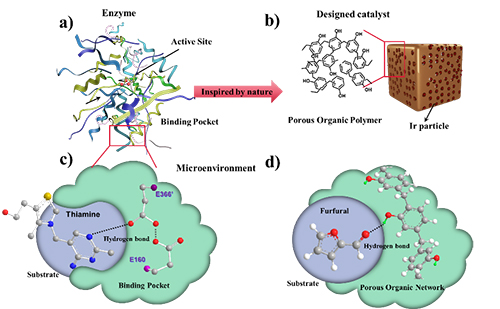Recently, Assoc. Prof. SHI Song from the Dalian Institute of Chemical Physics (DICP) of the Chinese Academy of Sciences (CAS), in collaboration with Prof. Dion Vlachos from the University of Delaware, have developed a new strategy for furfural conversion via hydrogen bond regulation.
This study was published in Nature Communications on Jan. 26.

Enzymes inspired microenvironment-controlled catalyst (Image by SHI Song)
In biomass upgrading, the selective conversion of biomass-based substrates is always difficult due to the various functional groups.
In this study, the researchers designed a porous organic framework-based catalyst. And inspired by enzyme catalysis in nature, they regulated the microenvironment of the active site by changing the functional groups over the porous organic framework. The change in the microenvironment could control the interaction between substrate and catalyst, improving the activity and selectivity of carbonyl-containing substrates such as furfural.
They found that the nearby hydroxyl groups around the active site form hydrogen bonds with the carbonyl groups in the substrate, thereby changing the adsorption conformation of the substrate on the catalyst surface and realizing the activity and selectivity control of different substrates.
"The proposed synthetic strategy opens a new class of porous polymers for selective catalysis," said SHI.
The above work was supported by the National Natural Science Foundation of China and the International Talent Program of DICP.